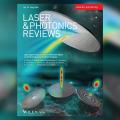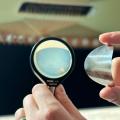News & Events
- Home
- News & Events
- News
News
2024. 03. 11
-
Symbols of Lithuania and Ukraine under the microscope: FTMC scientists support Ukrainian nation
 mini-d732d331a1155b520a5cd5f5f4f562d6.jpg)
Microscopic Columns of the Gediminids and stylized Ukrainian Trident made of gold and titanium. Photo: Dr. Ignas Grigelionis / FTMC
As Lithuanians celebrate the Day of Restoration of Independence of Lithuania on 11 March, we do not forget our Ukrainian brothers and sisters who have been fighting against the invaders for more than two years now.
To draw attention to the ongoing war and to express solidarity with Ukraine, Lithuanian scientists at the Center for Physical Sciences and Technology (FTMC) carried out an unusual experiment. They studied how terahertz light waves, invisible to the naked eye, are emitted by the heraldic symbols of the two countries, which have "decorated" gallium arsenide crystals.
These symbols, the Columns of the Gediminids and the stylised Ukrainian Trident, are made of gold and titanium and lithographed onto the crystals in the FTMC laboratory. An experiment with terahertz (spectral analysis) has shown that the symbols studied have similarities not only in a historical context, but also in the context of optics - the branch of physics that studies the behaviour and properties of light.

(Gallium arsenide crystals with hundreds of "drawings" of Tridents and Columns of the Gediminids, which are not visible to the naked eye. Comparison of sizes with a gilded Lithuanian cent. Photo: FTMC)

(This is what the crystal with the Ukrainian Tridents looks like, zoomed in 150 times. Photo: Dr. Ignas Grigelionis / FTMC)

(And here's a crystal with the Columns of the Gediminids, also zoomed in 150 times. Photo: Dr. Ignas Grigelionis / FTMC)
The main author of the scientific paper published on this topic is Barbora Škėlaitė, a third-year bachelor student at the Department of Optoelectronics of FTMC and a trainee at the Faculty of Physics of the Vilnius University. She explains that the structures on crystals (only in square or other, simple, shapes) are often studied and are useful for the formation of the desired terahertz light spectrum. But this time researchers wanted to try more complex shapes. The idea of what they would be like was inspired by events that we all know well.
"There is a war going on in Ukraine, and in support of this country, we decided to show the symbols of Ukraine and Lithuania in an unusual way. We wanted to see if there were any links between them in terms of the light spectrum - as we have historical links with Ukraine," says Barbora.
She initially used computer modelling to help her distinguish how individual parts of the microscopic symbols affected the light spectrum. The crystals containing the state symbols were then heated to 240 °C and the terahertz light signal emitted was measured.

(Barbora Škėlaitė and Dr. Ignas Grigelionis. Photo: FTMC)
"What is good about the Columns of the Gediminids and the Ukrainian Trident is that in principle they can be made of simple geometric shapes, rectangles. We expected that certain rectangles, parts of the symbols, would light up at slightly different frequencies. In the final result, we saw roughly what we expected," recalls Dr. Ignas Grigelionis, one of the authors of the study and a physicist in the Department of Optoelectronics.
Terahertz propagate through various materials that are opaque to the naked eye - for example, these waves can be used to see what's inside a paper envelope or a cardboard box. Terahertz is also increasingly used in airport security screening systems. They are light waves that are completely harmless to humans and are expected to replace dangerous X-rays in the future.
But there are obstacles - terahertz equipment is bulky and difficult to use. So, trying to develop the next generation of heat sources, lenses and metasurfaces (which act as light filters), FTMC researchers (and trainees) are looking for ways to make these systems more compact and user-friendly.

(The "composition" of the microscopic samples: a base layer of doped gallium arsenide at the bottom, an intermediate layer of gallium arsenide in the middle, and a titanium-gold metasurface on top. Illustration from a scientific paper by Barbora Škėlaitė and colleagues)
Meanwhile, the experiment with the symbols of Lithuania and Ukraine has both a practical and, even more, a symbolic meaning, as it reminds us at once of the heroic struggle of the Ukrainian people.
"I greet the 11th of March with the hope that the war will end in Ukraine's favour and success. I hope that everything will be all right," says B. Škėlaitė.
"My great hope is that we, the West, will not stop supporting Ukraine. Because there is a fight going on there for us too. Let's hope that we will not get tired of helping ourselves", wishes I. Grigelionis.
Written by Simonas Bendžius
Related news:

2024. 05. 13
-
Lithuanian research on the cover of the prestigious journal Laser & Photonics Reviews!
FTMC physicists have theoretically calculated, fabricated and laboratory tested innovative optical lenses for terahertz imaging.
-3f61eed94a14641c1b7b959f0775d214.jpg)
2023. 05. 24
-
Next-generation Thermal Terahertz Emission: how will science benefit from it?
Dr. Ignas Grigelionis talks about a new paper he and his colleagues published in an international journal.
